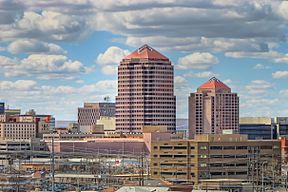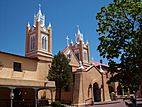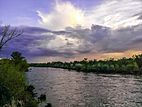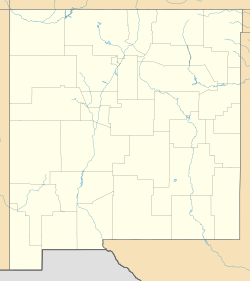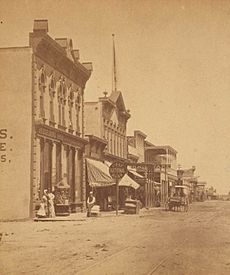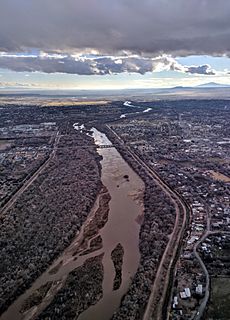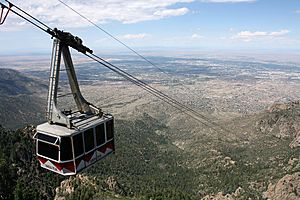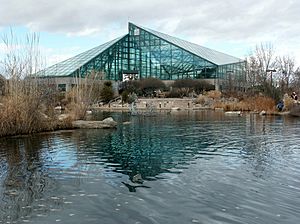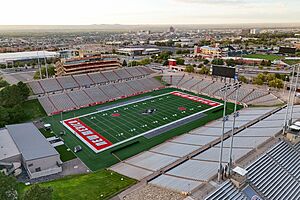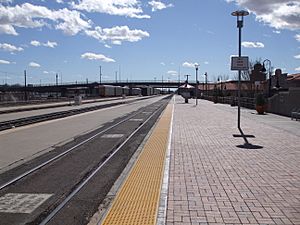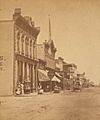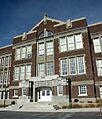Albuquerque, New Mexico facts for kids
Quick facts for kids
Albuquerque
|
|||
|---|---|---|---|
|
|||
| Nicknames:
The Duke City, ABQ, The 505, Burque, The Q.
|
|||
| Country | United States | ||
| State | New Mexico | ||
| County | Bernalillo | ||
| Metropolitan area | Albuquerque metropolitan area | ||
| Founded | 1706 (as Alburquerque) | ||
| Incorporated | 1891 (as Albuquerque) | ||
| Founded by | Francisco Cuervo y Valdés | ||
| Named for | Francisco Fernández de la Cueva, 10th Duke of Alburquerque | ||
| Government | |||
| • Type | Mayor–council government | ||
| Area | |||
| • City | 194.93 sq mi (489.39 km2) | ||
| • Land | 188.27 sq mi (486.03 km2) | ||
| • Water | 1.62 sq mi (4.35 km2) | ||
| Elevation | 5,312 ft (1,619 m) | ||
| Population
(2020)
|
|||
| • City | 564,559 | ||
| • Rank | 85th in North America 32nd in the United States 1st in New Mexico |
||
| • Density | 3,014.68/sq mi (1,163.97/km2) | ||
| • Urban | 769,837 (US: 59th) | ||
| • Urban density | 2,926.3/sq mi (1,129.9/km2) | ||
| • Metro | 960,000 (US: 61st) | ||
| Demonym(s) | Albuquerquean (uncommon), Burqueño, Burqueña | ||
| Time zone | UTC−7 (MST) | ||
| • Summer (DST) | UTC−6 (MDT) | ||
| ZIP Codes |
87101–87125, 87131,
87151, 87153, 87154, 87158, 87174, 87176, 87181, 87184, 87185, 87187, 87190–87199 |
||
| Area codes | 505 | ||
| FIPS code | 35-02000 | ||
| GNIS feature ID | 2409678 | ||
Albuquerque (pronounced AL-bə-kur-kee), also known as ABQ or the Duke City, is the largest city in the U.S. state of New Mexico. It was founded in 1706 by Governor Francisco Cuervo y Valdés and named after a Spanish duke. The city was an important stop on El Camino Real, a historic road connecting Mexico City to the northern parts of New Spain.
Albuquerque is located in the Albuquerque Basin, with the Sandia Mountains to the east and the West Mesa to the west. The Rio Grande river flows through the city. In 2020, Albuquerque had over 564,000 residents, making it the 32nd largest city in the United States. The wider Albuquerque area has about 955,000 people.
The city is a center for technology, arts, and media. It's home to the University of New Mexico, the famous Albuquerque International Balloon Fiesta, and many different restaurants.
Discover Albuquerque: A City of History and Fun
A Look Back in Time: Albuquerque's Story
Long before Europeans arrived, Native American people lived in the Albuquerque area. You can still see their ancient rock carvings, called Petroglyphs, at the Petroglyph National Monument. The Tiwa and Keresan peoples lived along the Rio Grande for centuries. Two of their pueblos, Sandia Pueblo and Pueblo of Isleta, have been continuously lived in for hundreds of years.
Albuquerque was officially founded in 1706 by the Spanish. It was a small farming town and an important trading and military outpost along the Camino Real. The city was built around a central plaza, which is now known as "Old Town Albuquerque". The San Felipe de Neri Church, built in 1793, is one of the oldest buildings there.
In 1862, during the American Civil War, Confederate soldiers briefly took over Albuquerque. However, Union troops soon pushed them out.
When the railroad arrived in 1880, it built a new area east of the old plaza, which became "New Town." This new area grew quickly and became the main commercial center. Albuquerque became an official city in 1891.
By 1900, Albuquerque had 8,000 people and modern features like an electric streetcar. The Alvarado Hotel was built next to the train station and was a city symbol for many years. Today, the Alvarado Transportation Center stands in its place, serving as a hub for buses and trains.
In the early 1900s, many people came to Albuquerque for its dry climate, hoping to recover from tuberculosis. This led to the growth of hospitals like Presbyterian Hospital. The famous Route 66 also passed through Albuquerque, bringing many travelers and leading to new motels and shops.
After World War II, the city grew even more, especially with the establishment of Kirtland Air Force Base and Sandia National Laboratories. These facilities made Albuquerque important in the "Atomic Age." The city's population continued to expand rapidly into the 21st century.
Where is Albuquerque? Geography and Nature
Albuquerque is in north-central New Mexico. It sits in the Rio Grande Valley, with the Sandia–Manzano Mountains to the east and the West Mesa to the west. The Rio Grande river flows right through the middle of the city.
Albuquerque is one of the highest major cities in the U.S. Its elevation ranges from about 4,900 feet (1,500 meters) near the Rio Grande to over 6,700 feet (2,000 meters) in the foothills. The highest point in the metropolitan area is Sandia Crest, which is 10,678 feet (3,255 meters) high.
The city's name, Sandía, means "watermelon" in Spanish. Some say it's because the mountains look pink and green at sunset, like a watermelon. Others believe it's because early Spanish explorers thought the squash growing near the Sandia Pueblo looked like watermelons.
The Rio Grande Valley State Park preserves a beautiful forest along the river, called the bosque. Here, you can see wildlife like porcupines and sandhill cranes. Other common animals in the city include roadrunners, coyotes, and New Mexico whiptail lizards.
How the City is Divided: Quadrants
Albuquerque is divided into four main sections called quadrants: Northeast (NE), Northwest (NW), Southeast (SE), and Southwest (SW). These are used in mailing addresses.
- Northeast (NE): This is the largest quadrant and is near the Sandia Mountains. It has many homes, the University of New Mexico, shopping malls, and Cliff's Amusement Park. Some of the wealthiest neighborhoods are here.
- Northwest (NW): This quadrant is home to historic Old Town Albuquerque and the Indian Pueblo Cultural Center. It also includes parts of Downtown Albuquerque, the Rio Grande Nature Center State Park, and the Petroglyph National Monument.
- Southeast (SE): Here you'll find Kirtland Air Force Base, Sandia National Laboratories, the Albuquerque International Sunport (the main airport), and the UNM South Campus. Popular neighborhoods like Nob Hill are in this area.
- Southwest (SW): This quadrant has a mix of older farming areas and newer neighborhoods. It includes the southern part of Downtown, the National Hispanic Cultural Center, the Rio Grande Zoo, and Tingley Beach.
Albuquerque's Weather: Sunny and Dry
Albuquerque has a sunny and dry climate, with over 300 sunny days a year! It's considered a "cold semi-arid climate."
- Winter: Days are cool and nights are cold, often dropping below freezing. Snowfall is light, averaging about 7.9 inches (20 cm) per winter.
- Spring: This season can be windy and is usually the driest time of year.
- Summer: Summers are long and warm to hot, but the low humidity makes it more comfortable. The city gets most of its rain during the "monsoon season" in July and August.
- Autumn: Mornings and nights are cool, with less rain than summer.
The mountains to the east create a "rain shadow" effect, meaning they block some moisture, making the city drier.
Water in the Desert City
Albuquerque gets its drinking water from two main sources: the Rio Grande river and an underground water supply called an aquifer. The city works hard to save water and manage its water resources for the future.
Fun Things to Do and See in Albuquerque
Arts and Culture in ABQ
Albuquerque is famous for the International Balloon Fiesta, the world's largest gathering of hot-air balloons. It happens every October and features hundreds of colorful balloons, live music, and crafts. Other big events include the Gathering of Nations, a large Native American pow wow, and the New Mexico State Fair.
You can visit many museums, like the New Mexico Museum of Natural History and Science, the Albuquerque Museum of Art and History, and the National Museum of Nuclear Science & History. In Downtown Albuquerque, you can see historic theaters like the KiMo Theater.
The Sandia Mountains offer fun activities year-round. You can ride the Sandia Peak Tramway, the second-longest passenger tramway in the world, to the top of Sandia Crest for amazing views. In winter, you can ski or snowboard at Sandia Peak Ski Area.
Albuquerque on Screen and Radio
Albuquerque is a popular place for filming movies and TV shows. Netflix has a big production studio here. Shows like Breaking Bad and Stranger Things (season 4) have filmed scenes in the city.
You might have heard of Albuquerque in cartoons! Bugs Bunny often says, "I knew I should have taken that left turn at Albuquerque" when he gets lost.
The city has many radio stations, playing everything from New Mexico music (a mix of local folk, rock, and Latin styles) to pop, rock, and country.
Delicious Food and Local Flavors
Albuquerque has many kinds of food, but it's especially known for its New Mexican cuisine. The red or green New Mexico chile pepper is a must-try ingredient found in many local dishes. You'll find many local restaurants and even some chains that started here, like Blake's Lotaburger.
The area also has vineyards that produce New Mexico wine and a growing number of local breweries.
Unique Architecture

Albuquerque's original buildings are in the Territorial Style, which was later revived. The Pueblo Revival style, inspired by Native American pueblos, is also very common, especially at the University of New Mexico.
At night, Albuquerque's cityscape is quite special, with many buildings lit up in vibrant colors. You can see the city lights twinkling from places like Nine Mile Hill.
Parks and Outdoor Fun
Albuquerque has over 290 public parks, covering about 23% of the city's area. The Bosque along the Rio Grande is a great place for hiking and biking. The Sandia–Manzano Mountains and Petroglyph National Monument also have many trails.
The Albuquerque Biological Park includes the ABQ BioPark Botanic Garden, ABQ BioPark Aquarium, Tingley Beach, and the ABQ BioPark Zoo. For thrill-seekers, there's Cliff's Amusement Park.
Sports in Albuquerque
Albuquerque is home to the Albuquerque Isotopes, a minor league baseball team. Their name comes from an episode of The Simpsons! The city also has a professional soccer team, New Mexico United, and an indoor football team, the Duke City Gladiators.
The University of New Mexico's sports teams, the Lobos, play college football at University Stadium and basketball at The Pit. Albuquerque is also a training ground for many famous MMA fighters.
Albuquerque's Economy: A Hub of Innovation
Albuquerque is New Mexico's main economic center. It has a diverse economy, focusing on science, medicine, technology, education, and entertainment.
The city is part of the New Mexico Technology Corridor, with important places like Kirtland Air Force Base, Los Alamos National Laboratory, and Sandia National Laboratories. These labs bring many highly educated scientists and researchers to the area. Big tech companies like Intel and Facebook also have facilities nearby.
The city is also seeing growth in the bioscience sector, with new companies and research centers. Film and TV production is also a big industry, with Netflix having a major studio here.
Learning in Albuquerque
Albuquerque is home to the University of New Mexico, the largest university in the state. Central New Mexico Community College (CNM) is also here, offering many different courses.
The Albuquerque Public Schools (APS) district serves all students in the city, with many public and charter schools. There are also several private schools available.
Getting Around Albuquerque
Roads and Highways
Albuquerque is a major crossroads with two large interstate highways:
- Interstate 25 (I-25), also called the Pan-American Freeway, runs north-south through the city.
- Interstate 40 (I-40), also called the Coronado Freeway, runs east-west.
The place where I-25 and I-40 meet is called the "Big I" and is a very large, complex interchange.
Public Transportation
ABQ RIDE operates the city's bus system, including the ART express bus service. The Alvarado Transportation Center in downtown is a central hub where you can connect to local buses, Amtrak trains, and Greyhound Lines buses.
The New Mexico Rail Runner Express is a commuter train that connects Albuquerque to nearby cities like Santa Fe and Belen.
Biking and Walking
Albuquerque has over 400 miles of trails and bike paths, making it a good city for cyclists. The city is working to improve its bike lanes and routes. While some areas are walkable, most people in Albuquerque rely on cars to get around.
Airports
The main airport is the Albuquerque International Sunport, located just southeast of downtown. It's the largest airport in New Mexico and serves millions of passengers each year. There's also a smaller airport, Double Eagle II Airport, used for private and corporate flights.
Images for kids
-
In 1706, Albuquerque was founded as a small town in Nuevo México, New Spain.
-
The McCanna–Hubbell Building, built in 1915, is one of downtown Albuquerque's many historic buildings.
-
Nocturnal view of Albuquerque from Sandia Peak Tramway upper terminal.
-
KiMo Theatre in Downtown.
-
Roosevelt Park is a historic park in central Albuquerque.
-
Aerial view of Interstate 40.
-
Alvarado Transportation Center, an intermodal transportation hub in downtown Albuquerque.
See also
 In Spanish: Albuquerque para niños
In Spanish: Albuquerque para niños


